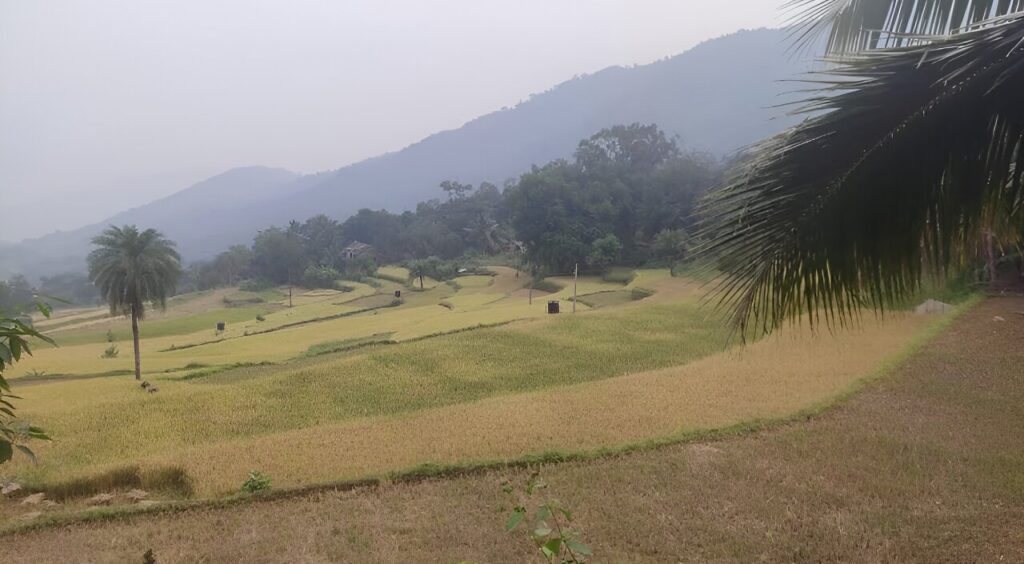

Bioversity International Alliance and the International Center for Tropical Agriculture
Fields in Odisha, India. Photo courtesy of HDI Survey Firm.
Odisha’s forested hills and rolling plains are home to some of India’s most vulnerable tribes, but a new study by researchers from the International Bioversity Alliance and CIAT shows that empowering women reduces the chances of their children being underweight.
According to World Health Organization (WHO) statistics, 828 million people worldwide were hungry and nearly 3.1 billion people lacked access to a healthy diet in 2020. India continues to struggle with food insecurity, malnutrition and rising anaemia among women and children, especially in rural and tribal areas like Odisha.
In recent years, there has been an increase in research on how women’s empowerment – giving women the ability to make strategic life choices and access to resources – can help eradicate hunger, but there is limited field evidence on its impact on food security, diet quality and child outcomes.
In the paper, “Women’s Empowerment, Household Diet Diversity and Child Anthropometry Among Vulnerable Populations in Odisha, India,” published in PLOS ONE, researchers from the International Bioversity Federation and CIAT used the Women’s Empowerment in Agriculture Index (WEAI) to measure women’s empowerment among 1,900 farming families across 12 districts in the Indian state of Odisha.
Sylvester Ogutu, a researcher at the International Bioversity Union and CIAT and lead author of the study, explains that by using this score and comparing it with outcomes such as the number of different foods present in the household and the weight of children by age, a clear picture emerged.
“As primary caregivers, women’s empowerment contributes to improved nutrition, health and education for children,” he said. “Women’s empowerment in agricultural input use, sales, income and other decision-making areas (access to credit, group membership, employment) was associated with reduced child underweight and wastedness.”
Jonathan Mockshell, agricultural economist at the International Bioversity Alliance and CIAT, study leader and co-author of the paper, said that in terms of the impact of women’s empowerment on Household Diet Diversity Score (HDDS) – a snapshot of a household’s economic ability to access a variety of foods and dietary diversity – the study found that women’s empowerment contributes to increased food production and dietary diversity.
“The magnitude of the effect of women’s empowerment on dietary diversity is relatively small, suggesting that complementary interventions may be needed to increase dietary diversity within the household,” he says.
The researchers also measured children’s height and weight and found that women’s empowerment significantly increased children’s weight-for-age Z-score (WAZ) and weight-for-height Z-score (WHZ), but not their height-for-age Z-score (HAZ).
“Improvements in Z-scores contributed to reduced rates of underweight and wasting in children of mothers with higher empowerment scores,” Mockshell said.
Ogutu explains that this new evidence on the impact of women’s empowerment on dietary diversity and children’s anthropometric measurements among vulnerable groups in India is very significant.
“However, the number of people who responded to our data on their children’s physical measurements, such as weight and height, was relatively small,” he says.
Mockshell said future studies could provide further insights by using larger datasets to examine the impact of women’s empowerment on children’s anthropometry.
“We also want to look at other vulnerable population groups in other parts of the Southern Hemisphere to see if we see similar trends,” he says.
The study builds on the authors’ previous work on improving the livelihoods of farmers in Odisha. In their paper, “Home gardens, household nutrition, and income among rural farmers in Odisha, India,” published in the Journal of Agricultural Economics in 2023, the researchers presented robust evidence that home gardens can improve food security, diet quality, and incomes in these rural villages.
This latest paper is part of a broader effort by the Bioversity International-CIAT coalition and the CGIAR Initiative on National Policies and Strategies aimed at generating evidence-based insights to support policy-making on women’s role in agriculture.
Researchers surveyed more than 1,500 smallholder farmers in the Sedhiou and Tambacounda regions of southern Senegal in February 2024. 70% of respondents were women aged 35 or older, aiming to empower women, who make up around 70% of Senegal’s agricultural workforce.
Further information: Sylvester Ogutu et al. “Women’s Empowerment, Household Diet Diversity, and Child Anthropometry Among Vulnerable Populations in Odisha, India.” PLOS ONE (2024). DOI: 10.1371/journal.pone.0305204
Courtesy of Bioversity International Alliance and the International Center for Tropical Agriculture.
Citation: Women’s Empowerment Associated with Fewer Underweight Babies in Vulnerable Indian Communities (August 19, 2024) Retrieved August 19, 2024 from https://medicalxpress.com/news/2024-08-women-empowerment-underweight-children-vulnerable.html
This document is subject to copyright. It may not be reproduced without written permission, except for fair dealing for the purposes of personal study or research. The content is provided for informational purposes only.
Tara Thomas Agency stands at the forefront of the entertainment industry, with years of experience dedicated to nurturing the most exceptional talents and successful acts.